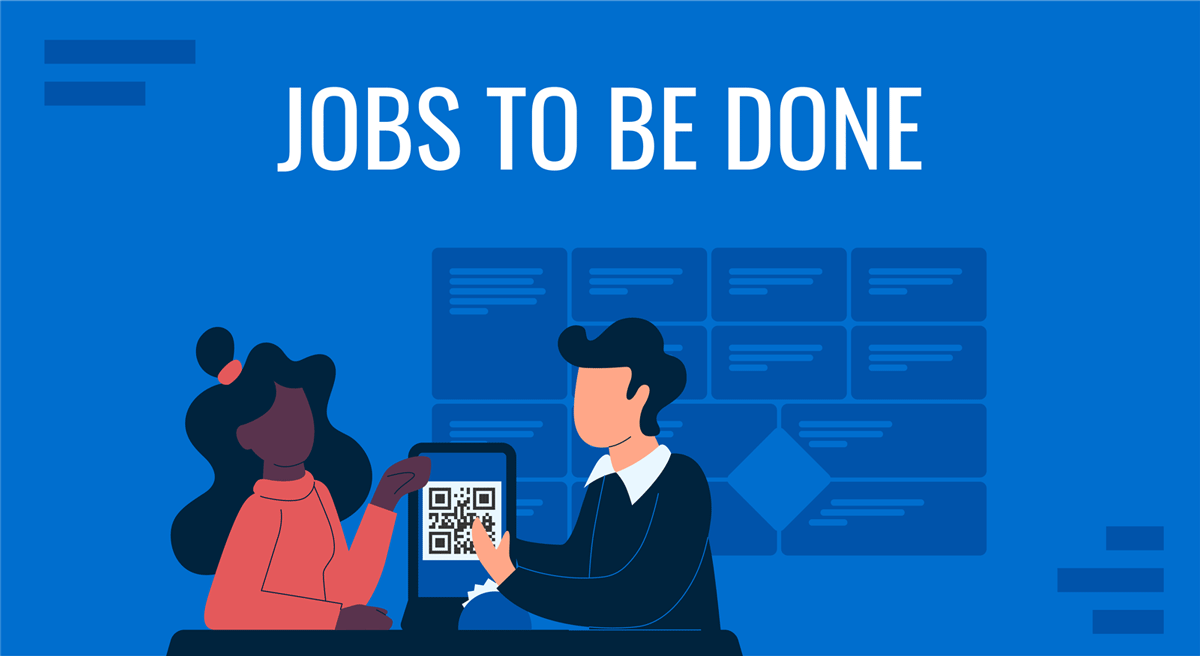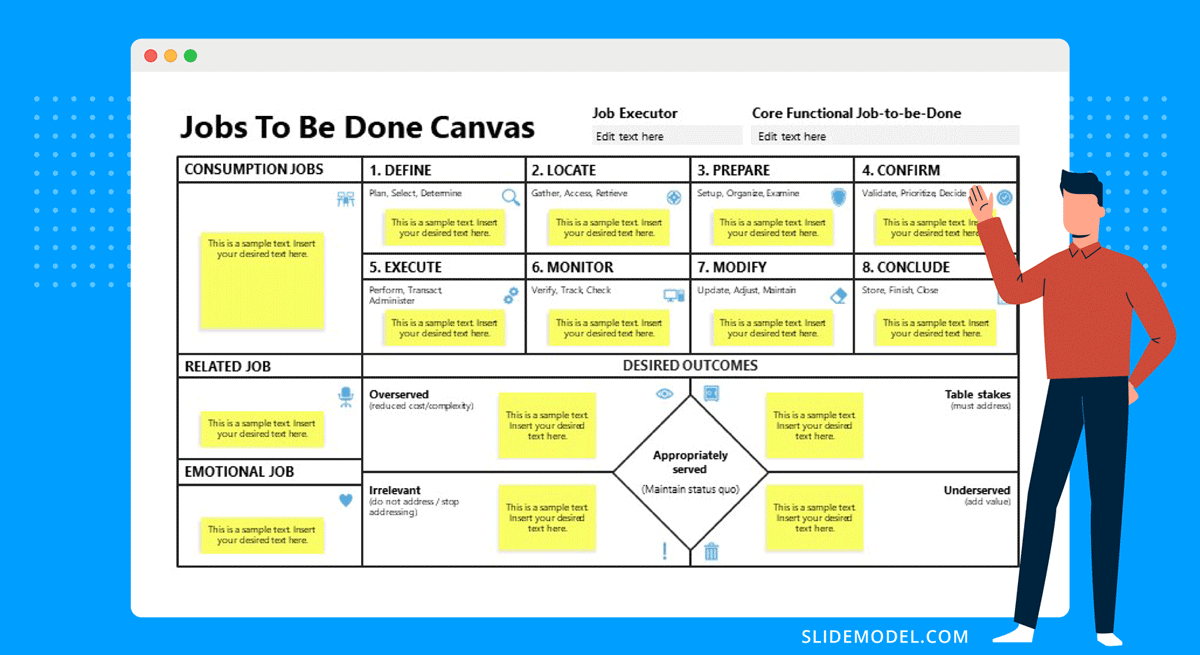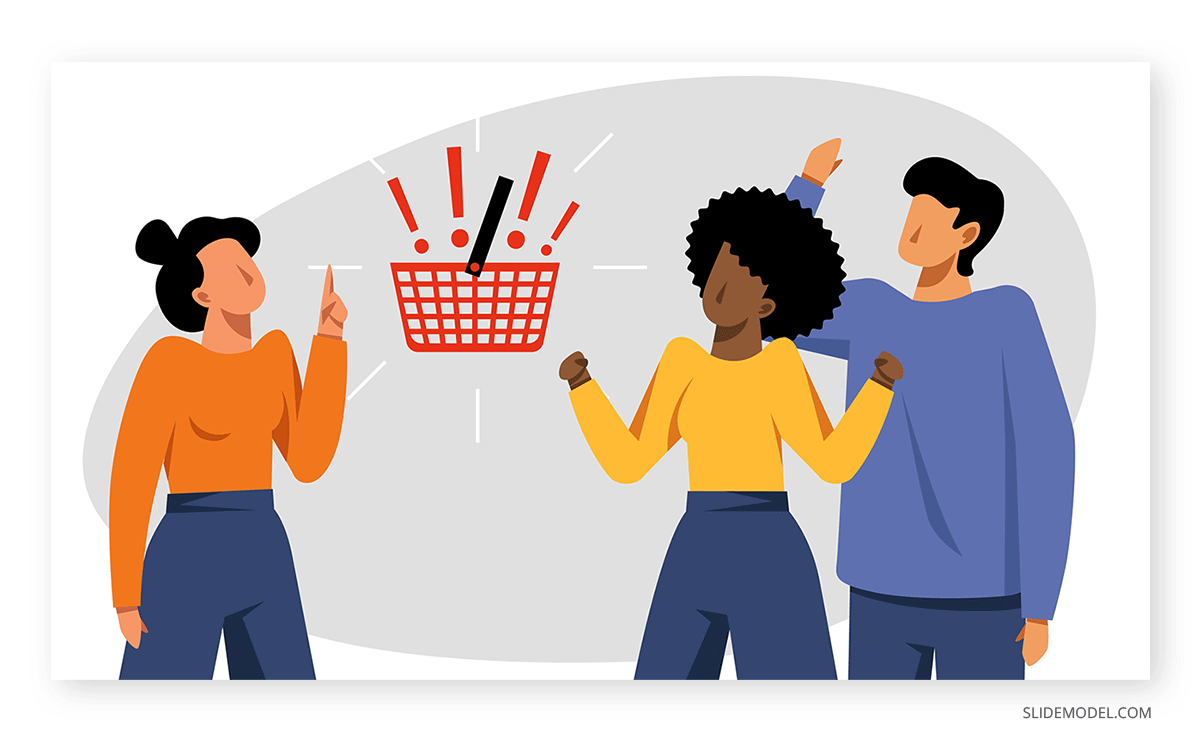“When we buy a product, we essentially ‘hire’ something to get a job done. If it does the job well, when we are confronted with the same job, we hire that same product again. And if the product does a crummy job, we ‘fire’ it and look around for something else we might hire to solve the problem.”
Clayton M. Christensen, Harvard Business School Professor on Innovation and Growth (1952-2020)

The jobs to be done framework is applied in developing a product or service that is suitable for customer needs. Not only does it guide in the step-by-step approach, but it also aids in employing the relevant market penetration strategies. In short, it is stopping you from building a very fast-flying car that no one wants to buy and helping you build the transportation system that carries people from place A to place B in a reasonable time. As Clayton proposed, customers want their jobs to be done and evaluate the future based on the task completed.
Table of Contents
- What is JTBD theory?
- JTBD Guiding principles
- JTBD frameworks into action
- First Stage – Identifying Needs and listing Jobs to be Done
- Stage Two – Working on the identified Jobs To Be Done
- Stage Three – Organize a Deeper understanding of needs
- Conclusion
What is JTBD theory?
Products and services must align with what customers want to succeed in business. Businesses should focus on the “Jobs Customers need to be done”
The Jobs to be done theory was initially proposed by Clayton M Christensen in his book “The Innovator’s Dilemma.” Several scholars have also contributed to this theory: Tony Ulwcik, Bob Moesta, and Chris Spiek. In short, the Jobs to be done theory explains how and why customers attract certain products and services into their lives. It helps to explore the market, competitors, customer needs, and segments, to effectively drive innovation and make a business profitable.

There are three levels of thinking about the jobs to be done. At a macro level of analysis, it is necessary to understand the customer’s life cycle, or their history of buying products over time (e.g., buying diapers for a baby to a toddler’s toy, then to the adolescent’s first smartphone), to determine their need for products over time.
At a micro level of analysis, it is necessary to understand the current and future needs for a product by time and situation (e.g., the need for an e-reader like a Kindle Paperwhite to be able to read books while on an airplane without carrying extra weight).
The last level of analysis is to identify a problem in the customer’s life and develop a solution that will ideally enhance the customer’s life.
By combining all three levels of analysis, businesses identify a product and develop a marketing strategy for it.
JTBD Guiding principles
The JTBD theory is a complex framework that focuses on providing a solution to businesses by proposing a tool that sets a pathway with clear guiding principles for tapping customer needs. As Theodore Levitt has said:
“People don’t want to buy a quarter-inch drill, they want a quarter-inch hole.”
Theodore Levitt – What Customers Want from Your Products – HBR
The guiding principles provide product owners with a clear direction for adapting the framework and driving business progress. It enables them to set clear goals and identify customer needs effectively. It contributes to service quality improvement by identifying service pain points and developing innovative solutions to address them.
Tony Ulwick, one of the pioneers of the Jobs-to-be-Done Theory, defines the principles as follows:
- People buy products and services to get a “job” done.
- Jobs are functional, with emotional and social components.
- A Job-to-be-Done is stable over time.
- A Job-to-be-Done is a solution agnostic.
- Success comes from making the “job” rather than the product or the customer, the unit of analysis.
- A deep understanding of the customer’s “job” makes marketing more effective and innovation far more predictable.
- People want products and services that will help them get a job done better and/or more cheaply
- People seek out products and services that enable them to get the entire job done on a single platform
- Innovation becomes predictable when “needs” are defined as the metrics customers use to measure success when getting the job done
JTBD frameworks into action
Product owners use the JTBD theory to create better products/services to fulfill the needs of their customers. They use different abstraction tools in real-life scenarios that help land the theory into actionable ideas.
Here in this article, we will show low complexity tools, following the process a real organization starting with this theory will use. Take into account that the theory and frameworks are deeper and require further reading. This article will help you start applying the theory while you investigate and learn.
First Stage – Identifying Needs and listing Jobs to be Done
The first step towards creating innovative products and product features is the ability of the organization’s product teams to brainstorm customer needs and challenges and identify the jobs required to meet those criteria. This exercise is a high-level abstraction created to put product owners in the shoes of customers.
Start with a clean canvas over a whiteboard, PowerPoint slide, Google Slides, or the tool that best fits your needs. The canvas is broken down into two basic vertical panels, where the left panel is subdivided into two horizontal panes ( leaving the canvas divided into 3 sections).
On the left side of the canvas, we have customer goals and motivations on top, and on the bottom, Customer challenges.
These sections are the beginning of the process. Product teams start listing ideas for customer needs and challenges.
Let’s create simple examples:
Context:
A software development company whose target segment is the new SME in the United States of America is analyzing new features to add to their ERP and CRM software solutions. The product team decided to work on the features targeted for sales teams and sales managers. Sale is an important variable in every company, and organizations invest in making their sales teams more productive and agile.
Imagine our fictional customer character, a sales executive in a corporation. The role involves defining the organization’s sales strategy, implementing the tactics, and managing a sales team to maximize the organization’s sales.
The product team defines the first goal motivation:
Customer Goal/Motivation N1) Spend more time analyzing sales team data (sales, quota, achievement, and forecast) in order to validate strategy and adjust tactics.
For Goal N1, the team agrees on the following challenges.
Customer Challenges N1.1) Information is sparse
Customer Challenges N1.2) Information is not up to date,
Customer Challenges N1.3) Information depends on sales team members’ actions to be uploaded.
Customer Challenges N1.4) Forecasting methods differ between sales team members.
After reviewing together the left side of the canvas and through conversation, the team agrees on the following job:
Job to Be Done N1) Help me to… automate manual sales process information So that I can… Spend more time analyzing sales team data.
This Job to be done is a powerful statement and involves a complete set of features. The first step towards innovation is identifying these jobs.
As the final stage of the exploratory analysis, the product team validates the job against the JBTD principles listed above. If there is consensus that the Job will comply, the analysis will continue in a deeper way.
Stage Two – Working on the identified Jobs To Be Done
The next step toward developing innovative features is to focus on the job; as principle #5 recommends, we are making the job the unit of analysis.
For this purpose, we will use the JTBD canvas. This is a lean ideation tool; it is used to brainstorm ideas around the JTBD done theory and learn the fundamentals. It helps identify areas in which products can improve consumers’ lives/experiences and help them solve a job.
The canvas is divided into the 6 sections of the JTBD framework (taken from the book Job to be done by Anthony Ulwick)
We will explain each section and apply it by analyzing the job identified in the previous exercise.
Job: Spend more time analyzing sales team data
1. The core functional job-to-be-done
The core functional job is analyzed through the Job Map tool. It aims to discover what the customer needs to get done at different steps of the job execution. A job map does not show what the customer is doing (a solution view); it describes what the customer is trying to get done (a needs view).

Define:
What aspects of getting the job done must the customer define up front in order to proceed?
The fictional customer needs to define which information will be used and compared to validate the sales team’s strategy and tactics achievements and progress. Also, define which information is loaded by the sales team members and which is the frequency of the load.
Locate:
What inputs or items must the customer locate to do the job?
Using the job example, the fictional customer needs effective sales information to be collected, centralized, and mapped against strategy and tactics combined with forecast and quota information. All of this is from different systems and platforms.
Prepare:
How must the customer prepare the inputs and environment to do the job?
The customer needs the information displayed using the same dimensions and comparable values over effective sales, forecast, and quota. It needs to see KPI through time range, to be able to compare progress.
Confirm:
To ensure its successful execution, what does the customer need to verify before proceeding with the job?
In our job example, the fictional customer should have a technical confirmation that the information is correct, up to date, and there are no issues with it to analyze.
Execute:
What must customers do to execute the job successfully?
This fictional customer will have access to interactive reports and displays with charts or other quantitative analysis tools in order to analyze the sales data.
Monitor:
What does the customer need to monitor to ensure that the job is successfully executed?
The best monitoring system for the example job is the time of analysis. Achieving the same conclusion will take less time if the job is improved.
Modify:
What might the customer need to alter for the job to be completed successfully?
Our customers might need to change visualizations or the time frame of evaluation in order to understand trends better.
Conclude:
What must the customer do to finish the job?
The fixionary customer needs to complete the analysis making a conclusion over each of the KPIs defined.
2. The desired outcomes tied to the core functional job-to-be-done
Job executors use desired outcomes to measure the successful execution of the core functional job. Note: desired outcomes are not solutions.
The bibliography suggests defining outcomes based on the mapped execution steps. This could generate a long list. Desired outcomes are mutually exclusive and non-dependent. This means you will end up with a long list of desired outcomes.
Once the desired outcomes list is generated, each outcome is rated as Overserved, Underserved, Irrelevant, Table Stake, and Appropriately Serviced. When applying the Jobs To be Done framework, large scale and with customers, you can conduct surveys and apply a formal formula to this rating, known as the Opportunity Algortihm™. This is out of the scope of the article, and we encourage product teams to just rate them according to their experience with customers, just to serve as a learning path.
In order to exemplify the identification of desired outcomes and how to classify them, we will continue using the previous example. Again, we break down the example per steps of the job execution process.
We start with execution as it is the simplest step to identify outcomes.
Execution:
Minimize the time it takes to complete the analysis of sales.
Rating: Table Stakes
The argument is that the team thought the time analyzing was not constrained by execution.
Define:
Reduce the number of individual comparisons to measure compliance with the strategy
Rating: Irrelevant
The argument of the team is that this is very dependent on the level of depth the sales manager wants to manage
Prepare:
Reduce the steps required to consolidate sales-related information.
Rating: Underserved
The argument is that lots of time for preparation are invested due to the number of steps of data cleansing and consolidation.
3. Related jobs
What other functional jobs is the executor trying to get done before, during, and after execution of the core job?
Apart from the core job being analyzed, executors often have related jobs that also need to be completed.
Returning to the core job example. Related jobs would be:
- Sell products/services
- Plan new sales strategies
- Coach/Train Sales Team Members
- Store information about accounts. (customers)
The related jobs help the analysis to avoid branching or going out of the boundary; just focus on the core job.
4. Emotional and social jobs
How do job executors want to feel by getting the job done? How do they want to be perceived by others?
Analyzing our core job example, we could derive the following emotional jobs:
- Be perceived as efficient
- Feel Admired by the Sales team
- Avoid being perceived as a micromanager
5. Consumption chain jobs
Which of these jobs must be executed to support product consumption? Who is responsible for execution?
Consumption chain jobs are product-related jobs that must get done throughout the product life cycle. One goal of innovation is to create solutions that eliminate or automate the execution of the consumption chain jobs
Based on our example, consumption jobs could be:
- Install the software (done by Other)
- Interconnect databases (done by Other)
- Interface with Sales Team Members (done by Other)
- Refresh Data (done by Other)
- Build Dashboards (Executor)
- Learn to Use Software (Executor)
Stage Three – Organize a Deeper understanding of needs
Once you have identified several Jobs To Be Done and have internally worked on different JTBD Canvas, it is time to get out of the building and start testing hypotheses with real customers. It is crucial that if ongoing developments are already proven wrong with the JTBD process, they are canceled. This will prevent further losses. For new products or feature developments, a new iteration of JTBD theory must be applied with the participation of customers or segments of customers that will be targeted to make a proof of reality.

Conclusion
To be a successful innovator, one must ask the right questions and clearly understand customers’ needs. Innovation derives from the needs and wants of consumers. The Jobs to be Done theory provides a framework that gives a solution to problems faced by consumers. It drives innovation and allows us to see the market through a new lens.
Developing a custom JTBD canvas from scratch can be a time-consuming process. Experts are always on the lookout for reusable templates that will help them pinpoint the root of the problem and devise an approach that will help them fix it quickly and easily. SlideModel has a workaround to help you elegantly employ jtbd canvas. It offers a number of customizable, industry-agnostic templates to be used in a wide range of situations. By adopting SlideModel templates, you can structure your proposals into practical, meaningful plans of action.
The incorporation of the JTBD framework in your organization ensures a unique vantage point for customer needs and issues. It helps to spot the goldmine behind a customer’s dissatisfaction and transform that experience into valuable products or services.


